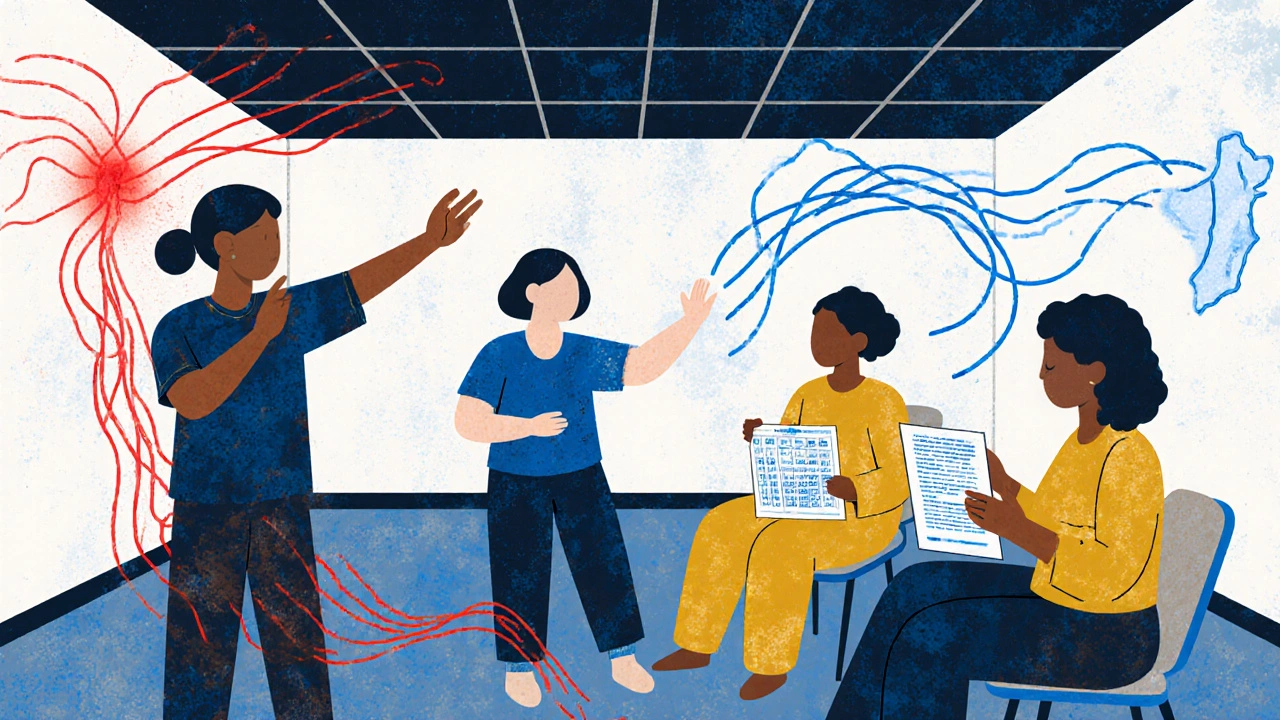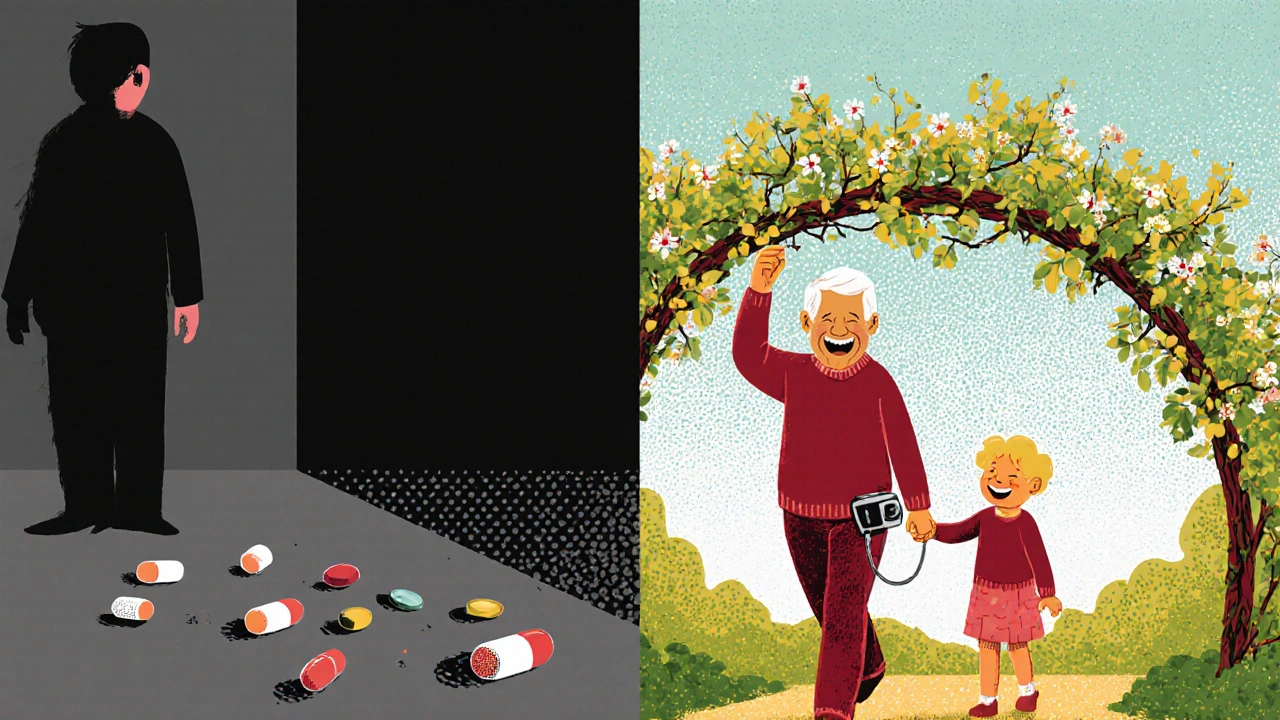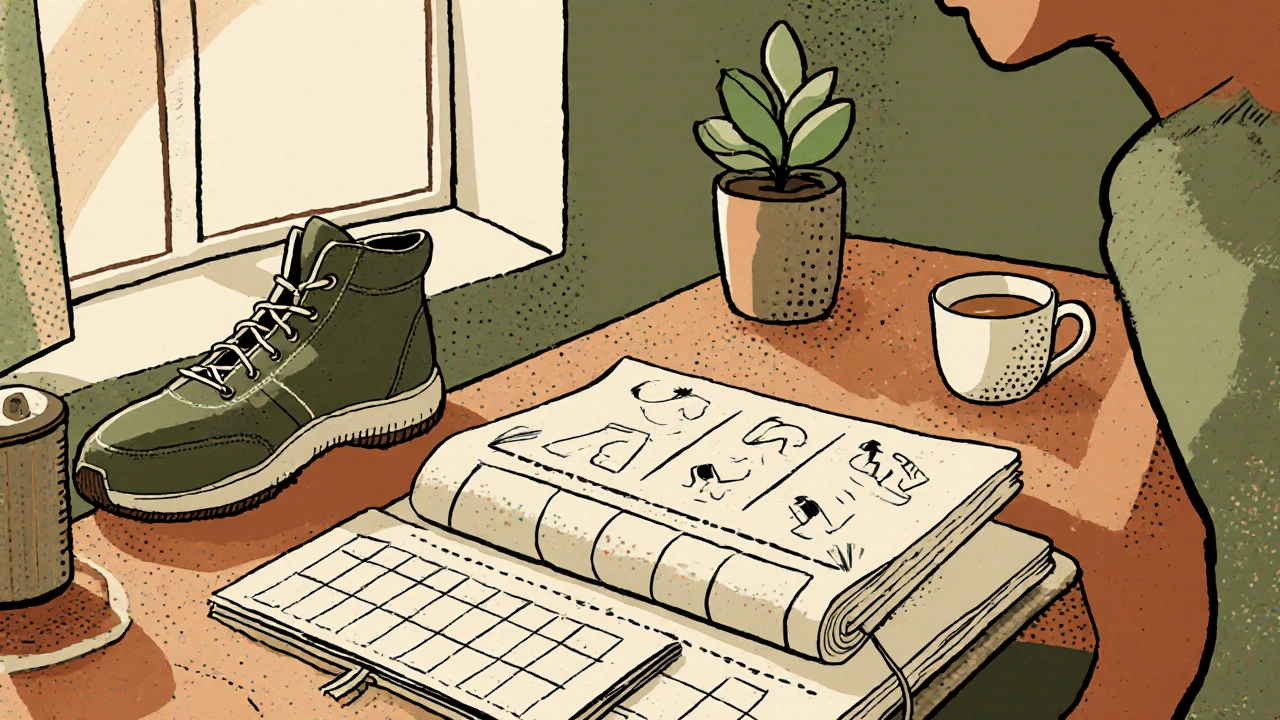Living with chronic pain isn’t just about hurting every day-it’s about learning how to live anyway. For over 50 million adults in the U.S. alone, pain doesn’t go away after an injury heals. It sticks around for months, years, even decades. And while medicine has long focused on pills to silence the pain, the real breakthrough isn’t in stronger drugs-it’s in changing how we think about pain itself.
Chronic Pain Isn’t Just Physical
Chronic pain isn’t a symptom. It’s a condition. The body’s alarm system gets stuck. Even when the original injury or illness is gone, nerves keep sending danger signals to the brain. That’s why simply popping painkillers often fails. You’re not treating the problem-you’re trying to mute a broken alarm.
The modern understanding of chronic pain comes from the biopsychosocial model. That means pain isn’t just in your nerves-it’s shaped by your emotions, your thoughts, your sleep, your stress levels, and even your social life. Someone with chronic back pain who’s anxious, isolated, and exhausted will feel it worse than someone with the same scan results but strong support, good sleep, and a routine that includes movement.
This shift in thinking changes everything. The goal isn’t to make pain disappear. It’s to help you live better despite it. That’s the core idea behind every evidence-based approach today.
What Works Better Than Opioids
Opioids used to be the default. But the data doesn’t lie. After three to six months, their pain relief fades. Meanwhile, risks climb-addiction, overdose, even worse pain over time. The CDC’s 2022 guidelines made it clear: opioids should be a last resort, not the first step.
So what’s better?
- Structured exercise: Walking, swimming, cycling, or strength training done 2-3 times a week for 6-12 weeks cuts pain by 15-30% and improves daily function by 20-40%. You don’t need to run a marathon. Just move consistently.
- Cognitive Behavioral Therapy (CBT): This isn’t talk therapy in the old sense. It’s a skill-building course. In 8-12 weekly sessions, you learn how pain affects your thoughts, how to challenge catastrophic thinking, and how to pace your activities. Studies show CBT reduces pain intensity by 25-40% and cuts disability by 30%. One veteran reduced his opioid use from 120 MME/day to 30 MME/day while functioning better.
- Multidisciplinary pain programs: These are intensive, three-week programs that combine physical rehab, psychology, occupational therapy, and education. At the Mayo Clinic, 65-75% of participants improved their ability to work or do daily tasks. Half reduced or quit opioids entirely.
Here’s the kicker: non-drug treatments don’t just match opioids-they beat them in long-term function. WHO’s 2023 guidelines say structured exercise leads to 25-35% better outcomes at one year than medication alone. And there’s zero risk of overdose.

The Real Barriers to Getting Help
If these treatments work so well, why are so many people still stuck on pills?
Access. Money. And ignorance.
Most primary care doctors didn’t get trained in these methods. A 2022 study found only 35% had completed the 15-20 hours of training needed to manage chronic pain properly. Many still think their options are: “take a pill or live in pain.” One Reddit user wrote: “My doctor only offered opioids or nothing.” That’s not rare.
Insurance won’t cover it. CBT, physical therapy, acupuncture-many plans deny these unless you jump through hoops. A 2023 survey found 65% of patients couldn’t afford recommended therapies. Another 42% got denied by insurers, even though guidelines say these treatments should be covered.
And then there’s geography. If you live in a rural area, you might be 100 miles from the nearest pain specialist. Only 22% of non-VA hospitals offer multidisciplinary programs. The VA, which has led the way, now offers them in 92% of its facilities. Outside the VA? Not even close.
How to Start Managing Your Pain Today
You don’t need a perfect plan. You need a starting point.
- Track your pain: Use a simple journal. Note pain level (0-10), what you did that day, how you slept, and your mood. Patterns emerge. Maybe pain spikes after sitting too long. Or improves after a walk.
- Move, even a little: Start with 10 minutes of walking daily. Add 5 minutes each week. If walking hurts, try water aerobics or tai chi. Movement doesn’t have to be intense-it just has to be regular.
- Find a CBT program: Look for programs offered through hospitals, VA centers, or online platforms like PainCourse or ThisWayUp. Many are covered by insurance now. Ask your doctor for a referral.
- Ask the right questions: If your doctor pushes opioids, ask: “What non-drug options have been shown to work for my condition?” If they say none, ask: “Can you refer me to a pain specialist?”
- Connect with others: Join a support group. Reddit’s r/ChronicPain has over 200,000 members. Talking to people who get it reduces isolation-the silent driver of worsening pain.

What’s Changing in 2025
The tide is turning, slowly.
Medicare expanded coverage for non-drug treatments in 2023. The NIH has poured $1.8 billion into developing non-addictive pain treatments. Over 37 new non-opioid drugs are in clinical trials. Digital tools like wearable nerve stimulators and FDA-cleared apps (like reSET-O) are now prescribed as part of treatment plans.
But the biggest change? Awareness. The American Chronic Pain Association’s 2024 Resource Guide is being used in clinics nationwide. It’s the first comprehensive, non-commercial guide to chronic pain management. It’s not about quick fixes. It’s about reclaiming control.
For the first time, pain specialists are talking about “function” more than “pain scores.” It’s not about whether your pain went from 8 to 3. It’s whether you can play with your grandkids, go to work, or sleep through the night.
It’s Not About Curing Pain. It’s About Reclaiming Life.
Chronic pain doesn’t vanish. But it doesn’t have to rule you either.
People who stick with non-drug approaches don’t just feel less pain-they feel more alive. They sleep better. They move more. They reconnect with family. They stop waiting for the pain to end before they start living.
That’s the real win.
You don’t need a miracle. You need a plan. And you’re not alone in this. Millions are walking this path. Some days are hard. But progress isn’t about pain disappearing. It’s about you getting your life back, one small step at a time.
Can chronic pain ever go away completely?
For most people, chronic pain doesn’t disappear entirely. But that doesn’t mean you can’t live well. The goal isn’t to eliminate pain-it’s to reduce its impact. Many people learn to manage their pain so it no longer controls their daily life. Studies show that with the right combination of movement, therapy, and self-management, over 60% of patients regain the ability to work, socialize, and sleep without relying on opioids.
Is CBT really effective for chronic pain?
Yes, and the evidence is strong. CBT doesn’t pretend pain isn’t real. Instead, it helps you change how you respond to it. After 8-12 sessions, patients typically report 25-40% less pain intensity, 30% less disability, and up to 50% less catastrophizing (the tendency to believe the worst about pain). One study found CBT was as effective as opioids at reducing pain-but patients improved their daily function by 45%, compared to just 20% with opioids. It’s one of the most proven tools available.
Why do doctors still prescribe opioids for chronic pain?
Many doctors still prescribe opioids because they were trained to do so-and because they don’t have time or resources to offer alternatives. Training in non-drug pain management isn’t required in most medical schools. Plus, insurance often doesn’t cover CBT or physical therapy, making pills the easiest option. But this is changing. Since the 2016 CDC guidelines, opioid prescriptions have dropped 15%. The challenge now is catching up on access to better options.
What if I can’t afford pain therapy or rehab programs?
Cost is a real barrier, but there are options. Many community health centers offer sliding-scale fees. The VA provides free multidisciplinary care to veterans. Online CBT programs like PainCourse cost under $100 and are often covered by insurance. Free resources like YouTube yoga for chronic pain, guided meditations from the UCLA Mindful Awareness Research Center, and local walking groups can help you start without spending money. Progress doesn’t require a pricey program-just consistency.
Are there any new treatments on the horizon?
Yes. Wearable neuromodulation devices like Nevro’s Senza and Boston Scientific’s Wave are now FDA-cleared and show 30-40% pain reduction in trials. Prescription digital therapeutics-apps that deliver CBT or mindfulness training-are becoming standard. Over 37 new non-opioid drugs are in clinical trials, targeting pain at the nerve level without addiction risk. The NIH’s HEAL Initiative is funding research into nerve repair, gene therapy, and non-addictive painkillers. These aren’t magic cures, but they’re promising tools that will expand options in the next few years.
How do I know if I’m getting the right care?
Ask these questions: Are they using tools like the Brief Pain Inventory or PROMIS to track function-not just pain levels? Are they offering exercise, CBT, or education before prescribing opioids? Are they checking in on your sleep, mood, and daily activities? If your care plan focuses only on pills, it’s incomplete. The gold standard is a team approach: doctor, physical therapist, psychologist, and pharmacist working together. If you’re not seeing that, ask for a referral to a pain specialist or multidisciplinary clinic.

9 Comments
Linda RosieNovember 23, 2025 AT 02:28
Finally, someone said it plainly: pain isn’t the enemy. Living in fear of it is.
Started walking 10 minutes a day. Now I garden again. No magic. Just consistency.
Vivian C MartinezNovember 23, 2025 AT 16:44
This is exactly the kind of information that should be standard in every primary care office. CBT and movement aren’t alternatives-they’re foundations. I’ve seen patients transform when given the tools, not just pills. Thank you for sharing evidence-based hope.
Ross RuprechtNovember 24, 2025 AT 22:40
Ugh. Another ‘just move more’ post. I’ve been walking for five years. My pain’s worse. Where’s the real solution? Not this feel-good fluff.
Bryson CarrollNovember 26, 2025 AT 05:28
Look at this. Another sanctimonious listicle pretending chronic pain is just a mindset problem. You think I don’t know about CBT? I’ve done ten sessions. It didn’t fix the fact that my nerves are fried. This whole ‘non-drug’ crusade ignores biology. It’s just opioid-phobia dressed up as enlightenment
Jennifer ShannonNovember 27, 2025 AT 23:58
I’ve lived with fibromyalgia for 17 years, and I can tell you-this isn’t just advice, it’s a lifeline. The biopsychosocial model? It’s not just academic-it’s the reason I’m still here. I used to think if I just pushed harder, the pain would disappear. But pain isn’t a puzzle to solve, it’s a conversation to have. When I stopped fighting it and started listening-to my body, my sleep, my anxiety, my loneliness-that’s when things changed. Movement didn’t cure me, but it gave me back my mornings. CBT didn’t silence the noise, but it taught me how to sit with it without drowning. And the support groups? They didn’t fix my spine, but they fixed my sense of being alone. The real breakthrough isn’t in the lab-it’s in the quiet act of showing up for yourself, day after day, even when it hurts. You don’t need to be fixed. You just need to be seen. And now, finally, the medical world is starting to look up from its charts and see us.
Suzan WanjiruNovember 28, 2025 AT 19:48
Agreed on the access issue. My local clinic doesn’t have a single PT who takes my insurance. I had to drive 45 miles to get a referral. And the online CBT program? Took 3 months to get approved. Insurance says it’s ‘experimental.’ It’s 2025. This is ridiculous. Start with walking. Start with breathing. Don’t wait for permission to begin.
Kezia Katherine LewisNovember 29, 2025 AT 05:19
From a clinical standpoint, the biopsychosocial framework remains the most robust paradigm for chronic pain management. The neuroplasticity of nociceptive pathways, coupled with central sensitization and descending modulatory dysfunction, renders pharmacological monotherapy fundamentally inadequate. Multimodal interventions-particularly those integrating somatic re-education, cognitive restructuring, and affective regulation-demonstrate superior longitudinal outcomes in both pain disability indices and quality-of-life metrics. The VA model is indeed exemplary, and its scalability should be prioritized in public health policy.
Manjistha RoyNovember 30, 2025 AT 09:52
I come from a small village in India where pain is often seen as something you endure, not treat. But I learned from my sister’s journey with arthritis: movement, even gentle, and talking to someone who understands, changes everything. You don’t need fancy clinics. You need someone to sit with you. And that’s something we can all do.
Jennifer SkolneyDecember 1, 2025 AT 18:08
This gave me chills. I started CBT last year. I cried in session #3. I laughed in session #7. Now I’m hiking with my daughter again. I still have pain. But I’m not afraid of it anymore. 💪❤️